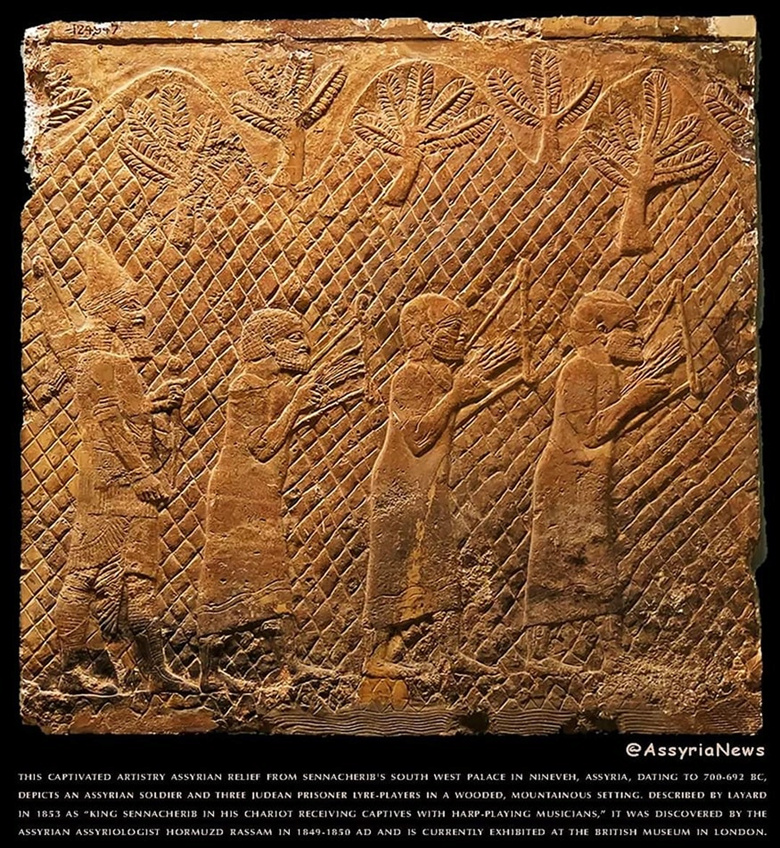An Assyrian soldier and three Jewish harpists

His captivating Assyrian relief from Sennacherib's southwestern palace in Nineveh, Assyria, dating from 700-692 BC, depicts an Assyrian soldier and three Jewish prisoner harpists in a wooded, mountainous setting. Layard described it in 1853 as “King Sennacherib in his chariot receiving prisoners with harp players.” It was discovered by the Assyrian scholar Hormizd Rassam in 1849-1850 AD, and it is currently displayed in the British Museum in London.
Sennacherib (Akkadian: , spelled “Sîn-ahhī-erība”, meaning “Sin has taken the place of the brothers”), The sixth king of the Neo-Assyrian Empire, and the second of its rule from the Sargonic dynasty, his sultanate lasted more than 24 years, starting from the time his father passed away in 705 BC, until his death in 681 BC. He was a powerful king who often conquered. His fame, which extended to the lands of the West, stems from the role he played in the Bible, which described his famous campaign in the Levant. Other pivotal points in this king's rule include his destruction of the city of Babylon in 689 BC and the renovation and expansion of Nineveh, the last great capital of Assyria.
The young king's rule began with the difficult task of conquering Babylon, which formed the southern crown jewel of his empire. Many of Sennacherib's Babylonian problems arose from the leader of the Chaldean tribe, Marduk-apla-iddina II.
Who was king on the throne of Babylon until he was overthrown by Sennacherib's father, King Sargon II. Shortly after Sennacherib inherited the throne of the empire in 705 BC, Marduk-apla-iddina regained Babylon and allied himself with the Elamites. Although Sennacherib reconquered the south in 700 BC, Marduk-apla-iddina continued to harass him, and he may have been the one who incited the Assyrian allies in the Levant to revolt, which led to the ignition of the war of 701 BC. He himself fought against “Bel my son,” the puppet king of “Sennacherib” in Babylon. In Sennacherib's campaign against the Levant, the states located in the south, especially the Kingdom of Judah, were not as easy to submit as those located in the north (Azekah, Lachish). Therefore, “Sennacherib” invaded Jerusalem with soldiers that filled the space. The outcome of the siege that Sennacherib imposed on Jerusalem is still a matter of debate, although the Hebrew narrative claims that divine intervention by angels sent by God ended Sennacherib’s attack after they destroyed the Assyrian army battalions. However, the Assyrian defeat in this battle is indisputable. It is likely that Hezekiah, King of Judah, would surrender at the end of the campaign. Contemporary records, even those written by enemies of Assyria, do not mention the defeat of the Assyrians at Jerusalem. After a short period of relative calm throughout the kingdom, peace was dispersed, when the Babylonians and Elamites captured and executed Sennacherib's eldest son and heir apparent, Ashur-nidin-Shumi, whom Sennacherib had declared king of Babylon. Sennacherib's response to this betrayal was earth-shattering, and the story he left to tell the events of his revenge was full of hatred. He launched a harsh campaign in both regions. The first was in the year of the Kingdom of Elam. Sennacherib sailed with his fleet, crossing the Gulf of Arabia and landing in Persia. He penetrated the country, thickened it, and destroyed it. Before returning to Assyria, then it was Babylon's turn. He marched with his army to the capital of the south, destroyed its forts and palaces, slaughtered a large portion of its population, and turned large parts of the city into the ground, by diverting the water course of the Tigris and Euphrates rivers to it, and captured the statue of its great god, Marduk. After that, he By leveling its walls.
Source: websites

